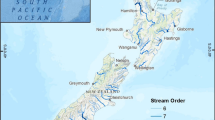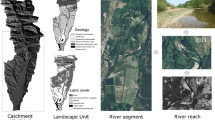Abstract
In recent years the conceptual barriers between river `management' and river `conservation' have begun to erode. As the environmental aspirations of water managers and conservationists broaden, there is a need for integrated methods of conservation assessment which can be of value to both groups. This paper considers the requirements inherent in such methods, and explores some of the problems in their design, using for illustration the development of SERCON (System for Evaluating Rivers for Conservation) in the UK. The design of integrated assessment methods, including the selection of attributes for evaluation, must be closely related to the objectives of any conservation activity. For example, selecting a representative series of rivers for statutory protection may require more focused assessment techniques than those needed for setting river conservation management objectives. In the European Union, the Habitats Directive provides a good example of the former approach, in which specific river types and species listed in the Directive must be evaluated for selecting Special Areas of Conservation. In contrast, the forthcoming Water Framework Directive will need to rely on a more comprehensive method of integrated assessment to ensure that `good ecological quality' can be reliably defined, monitored and maintained. Attempts at developing integrated conservation assessment methods need to address six main issues: (i) differences in perception of conservation `value'; (ii) defining conservation criteria (such as `naturalness'), many of which are to an extent subjective; (iii) establishing weighting systems to differentiate important from less important conservation features; (iv) ensuring that methods are rigorous and consistent; (v) the need for extensive datasets to allow comprehensive assessment; and (vi) providing clear guidance on interpreting the outputs. This paper illustrates these problems using experience gained in the UK. It concludes that the inevitable search for pragmatism should not detract from the need for an inclusive approach to river conservation assessment.
Similar content being viewed by others
References
Angermeier, P. L. & J. R. Karr, 1994. Biological integrity versus biological diversity as policy directives. BioScience 44: 690–697.
Angermeier, P. L. & M. R. Winston, 1997. Assessing conservation value of stream communities: a comparison of approaches based on centres of density and species richness. Freshwat. Biol. 37: 699–710.
Angermeier, P. L., R. J. Neves & L. A. Nielsen, 1991. Assessing stream values: perspectives of aquatic resource professionals. N. am. J. Fisheries Manage. 11: 1–10.
Angermeier, P. L., R. J. Neves & J. W. Kauffman, 1993. Protocol to rank value of biotic resources in Virginia streams. Rivers 4: 20–29.
Blyth, J. D., 1983. Rapid stream survey to assess conservation value and habitats available for invertebrates. In: Myers, K., C. R. Margules & I. Musto (eds), Survey Methods for Nature Conservation. Proceedings of a workshop held at Adelaide University, 31 August-2 September 1983. CSIRO Division of Water and Land Resources, Canberra, Australia: 1: 343–375.
Boon, P. J., 1992. Essential elements in the case for river conservation. In: Boon, P. J., P. Calow & G. E. Petts (eds), River Conservation and Management, John Wiley, Chichester, 11–33.
Boon, P. J., 1994. Nature conservation. In: Maitland, P. S., P. J. Boon & D. S. McLusky (eds), The Fresh Waters of Scotland: A National Resource of International Significance, John Wiley, Chichester: 555–576.
Boon, P. J., 1995. The relevance of ecology to the statutory protection of British rivers. In Harper, D. M. & A. J. D. Ferguson (eds), The Ecological Basis for River Management. John Wiley, Chichester, 239–250.
Boon, P. J. & D. L. Howell (eds), 1997. Freshwater Quality: Defining the Indefinable? The Stationery Office, Edinburgh, 552 pp.
Boon, P. J., N. T. H. Holmes, P. S. Maitland & T. A. Rowell, 1994. A system for evaluating rivers for conservation ('SERCON'): An outline of the underlying principles. Verh. int. Ver. Limnol. 25: 1510–1514.
Boon, P. J., N. T. H. Holmes, P. S. Maitland & T. A. Rowell, 1996. SERCON: System for Evaluating Rivers for Conservation. Version 1 Manual. Scottish Natural Heritage Research Survey and Monitoring Report No. 61, Scottish Natural Heritage, Edinburgh.
Boon, P. J., N. T. H. Holmes, P. S. Maitland, T. A. Rowell & J. Davies, 1997. A system for evaluating rivers for conservation (SERCON): development, structure and function. In: Boon, P. J. & D. L. Howell (eds), Freshwater Quality: Defining the Indefinable? The Stationery Office, Edinburgh: 299–326.
Boon, P. J., J. Wilkinson & J. Martin, 1998. The application of SERCON (System for Evaluating Rivers for Conservation) to a selection of rivers in Britain. In: Boon, P. J. & P. J. Raven (eds), The Application of Classification and Assessment Methods to River Management in the UK. Aquat. Conserv. Mar. Freshwat. Ecosyst. (special issue) 8: 597–616.
Cairns, J., 1995. Ecological integrity of aquatic systems. Regul. Rivers Res. Manage. 11: 313–323.
Collier, K. J. & R. H. S. McColl, 1992. Assessing the natural value of New Zealand rivers. In Boon, P. J., P. Calow & G. E. Petts (eds), River Conservation and Management. John Wiley, Chichester: 195–211.
Council of the European Union, 1999. Amended proposal for a Council Directive establishing a framework for Community action in the field of water policy, 19 February 1999, Brussels.
Davies, J. & W. Giesen, 1994. Towards a methodology for identifying tropical freshwater wetlands for protection. Mitt. int. Ver. Limnol. 24: 27–39.
Dudgeon, D. 1992. Endangered ecosystems: a review of the conservation status of tropical Asian rivers. Hydrobiologia 248: 167–191.
English Nature, 1997. Beyond 2000: English Nature's Strategy for Improving England's Wildlife and Natural Features, Peterborough.
Goodman, S. L., W. Seabrooke & S. A. Jaffry, 1998. Considering conservation value in economic appraisals of coastal resources. J. Envir. Plan. Manage. 41: 313–336.
Green, C. H. & S. M. Tunstall, 1992. The amenity and environmental value of river corridors in Britain. In: Boon, P. J., P. Calow & G. E. Petts (eds), River Conservation and Management. John Wiley, Chichester, 425–441.
Harvey, D. 1981. Conservation surveys-what do we need and how do we put it across? In: Harper, D. (ed.), Assessing the Conservation Value of Rivers. Department of Adult Education, University of Leicester: Leicester, 21–31.
Holdgate, M. 1997. What future for nature? Lecture at Edinburgh International Science Festival, 3 April 1996. Scottish Natural Heritage Occasional Paper No. 4, SNH, Edinburgh.
Holmes, N. T. H. 1983. Typing British rivers according to their flora. Focus on Nature Conservation 4. Nature Conservancy Council, Peterborough.
Holmes, N. T. H. 1989. British rivers-a working classification. Br. Wildlife 1: 20–36.
Holmes, N. T. H., P. J. Boon & T. A. Rowell, 1998. A revised classification system for British rivers based on their aquatic plant communities. In: Boon, P. J. & P. J. Raven (eds), The Application of Classification and Assessment Methods to River Management in the UK. Aquat. Conserv. Mar. Freshwat. Ecosyst. (special issue) 8: 555–578.
Karr, J. R. 1991. Biological Integrity: a long-neglected aspect of water resource management. Ecol. Appl. 1: 66–84.
Litton, G. 1997. Environmental impact of river and stream hydropower. Unpublished report to the Countryside Council forWales, Bangor.
Macmillan, L. A. 1983. A method for identifying small streams of high conservation status. In Myers, K., C. R. Margules & I. Musto (eds), Survey Methods for Nature Conservation. Proceedings of a workshop held at Adelaide University, 31 August-2 September 1983, CSIRO Division ofWater and Land Resources, Canberra, Australia: 1, 319–342.
Nature Conservancy Council, 1984. Nature Conservation in Great Britain. Peterborough.
Nature Conservancy Council, 1989. Guidelines for Selection of Biological SSSIs. Peterborough.
O'Keeffe, J. 1997. Methods of assessing conservation status for natural fresh waters in the Southern hemisphere. In: Boon, P. J. & D. L. Howell (eds), Freshwater Quality: Defining the Indefinable? The Stationery Office, Edinburgh: 369–386.
O'Keeffe, J. H. & B. R. Davies, 1991. Conservation and management of the rivers of the Kruger National Park: suggested methods for calculating instream flow needs. Aquat. Conserv. Mar. Freshwat. Ecosyst. 1: 55–71.
O'Keeffe, J. H., D. B. Danilewitz & J. A. Bradshaw, 1987. An 'expert system' approach to the assessment of the conservation status of rivers. Biol. Conserv. 40: 69–84.
Pollard, P. & M. Huxham, in press. The European Water Framework Directive: a new era in the management of aquatic ecosystem health? Aquat. Conserv. Mar. Freshwat. Ecosyst.
Rabe, F. W. & N. L. Savage, 1979. A methodology for the selection of aquatic natural areas. Biol. Conserv. 15: 291–300.
Ratcliffe, D. A. (ed.), 1977. A Nature Conservation Review, Cambridge University Press, Cambridge.
Raven, P. J., P. Fox, M. Everard, N. T. H. Holmes & F. H. Dawson, 1997. River Habitat Survey: a new system for classifying rivers according to their habitat quality. In: Boon, P. J. & D. L. Howell (eds), Freshwater Quality: Defining the Indefinable? The Stationery Office, Edinburgh: 215–234.
Raven, P. J., N. T. H. Holmes, F. H. Dawson & M. Everard, 1998. Quality assessment using River Habitat Survey data. In: Boon, P. J. & P. J. Raven (eds), The Application of Classification and Assessment Methods to River Management in the UK. Aquat. Conserv. Mar. Freshwat. Ecosyst. (special issue) 8: 477–499.
Schneiders, A., E. Verhaert, G. D. Blust, C. Wils, L. Bervoets, & R. F. Verheyen, 1993. Towards an ecological assessment of watercourses. J. Aquat. Ecosyst. Health 2: 29–38.
Tunstall, S., M. Fordham, C. Green, & M. House, 1997. Public perception of freshwater quality with particular reference to rivers in England and Wales. In: Boon, P. J. & D. L. Howell (eds), Freshwater Quality: Defining the Indefinable? The Stationery Office, Edinburgh: 39–58.
Ward, J. V. 1998. Riverine landscapes: biodiversity patterns, disturbance regimes, and aquatic conservation. Biol. Conserv. 83: 269–278.
Wishart, M. J., B. R. Davies, P. J. Boon & C. Pringle, in press. Global disparities in river conservation: 'first-world' values and 'third-world' realities. In: Boon, P. J., B. R. Davies & G. E. Petts (eds), Global Perspectives on River Conservation: Science, Policy and Practice. John Wiley, Chichester.
Wright, J. F., P. D. Armitage, M. T. Furse & D. Moss, 1989. Prediction of invertebrate communities using stream measurements. Regul. Rivers Res. Manage. 4: 147–155.
Author information
Authors and Affiliations
Rights and permissions
About this article
Cite this article
Boon, P.J. The development of integrated methods for assessing river conservation value. Hydrobiologia 422, 413–428 (2000). https://doi.org/10.1023/A:1017054908152
Issue Date:
DOI: https://doi.org/10.1023/A:1017054908152




